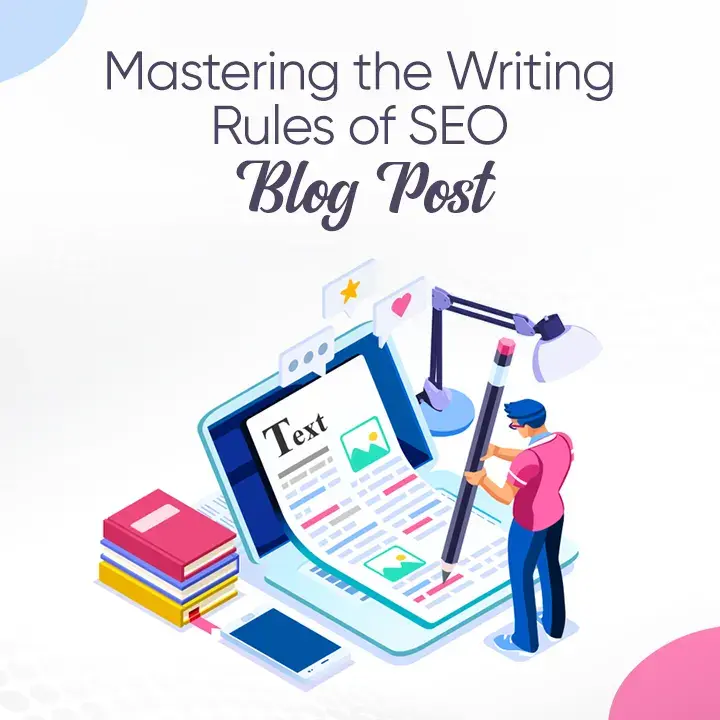Table of Content
| Know About the Rules to Write a Quality SEO Friendly Blog Post |
| What is SEO-friendly Blog? |
| How to Write SEO Friendly Blog Post: Key Rules to Follow |
| Frequently Asked Questions |
| Final Words |
Know About the Rules to Write a Quality SEO Friendly Blog Post
During the last few years, SEO has become an integral part of digital marketing. Many companies are strictly paying attention to SEO to get good presence on Google, as the majority of organic traffic depends on it. There are various things included in SEO that matters a lot for good SERP results. The writing of a quality SEO blog holds high importance in this regard. It plays a major role in ranking keywords that are targeted towards your product or service. Therefore, it is important for you to understand how to write SEO friendly blog post that can rank your website on top of Google.
Many people think that writing an SEO friendly blog is similar like writing any other article. Well, this is not entirely true, because SEO writing requires you to focus on different other things. It is not just about keywords that you need to consider while writing, the buildup of tone, structure and story also plays a huge role in this regard. These things are often not known to the beginner writers, which is why they usually struggle while offering blog writing services to different clients.
In this blog, we will answer most of these questions. We will let you know how to write SEO friendly blog post in an appropriate manner. Let’s first start from the basics understanding what is an SEO blog and why does it matter for search engine ranking.
What is SEO-friendly Blog?

An SEO blog post is a carefully crafted piece of blog content designed to enhance a website’s visibility in search engine results pages. The primary goal of an SEO blog post is to attract organic traffic by incorporating relevant keywords, phrases, and information that align with the search queries users may enter into search engines. These blog posts are strategically optimized to rank higher in search engine algorithms, thereby increasing the likelihood of users discovering and clicking on them.
Effective SEO blog posts go beyond keyword placement, as they also focus on delivering valuable and engaging content to the target audience. This content should be informative, well-structured, and address the needs and interests of the readers. By providing high-quality information, SEO blog posts not only cater to the search engines but also aim to establish credibility and trust with the audience. This user-centric approach not only enhances the user experience but also contributes to long-term SEO success.
Keep your blog fresh and engaging with our professional writers!
Engage Readers
To maximize the impact of an SEO blog post, it’s essential to consider various on-page and off-page SEO factors. On-page elements include optimizing meta titles, meta descriptions, headings, and images, while off-page factors involve building relevant backlinks and social media promotion. Regularly updating content, maintaining a mobile-friendly design, and adhering to SEO best practices are crucial for ensuring the sustained visibility and ranking of a blog post in search engine results.
How to Write SEO Friendly Blog Post: Key Rules to Follow

Writing an SEO friendly blog is not that difficult if you’ve got the basics covered. It is a little different from conventional writing, hence you need to take care of those points that are important in these blog posts.
If you do not know how to write SEO friendly blog post properly, take a look at the points defined below. It will clear your concepts related to SEO writing, allowing you to understand how it should be done as per the on-page requirements.
Evaluate Google Results
Market research is considered important for all types of writing jobs. Whether you are writing for a newspaper or an online blog, you need to first see the practices that are followed by the people. In SEO writing, this concept also remains the same. As a writer, you can start conducting research by looking into Google or any other search engine. It is the best way to know how people are creating blogs, and what type of things they are discussing in the content.
This practice helps a lot to the beginners, as they usually do not know the rules of SEO writing. Most of them think that SEO blogs can be written randomly without following any content ideation strategy. Well, this is a wrong concept, because SEO blogs require a complete structure from the start to finish. Unlike other blogs, you cannot discuss anything out of the topic in these blogs. You have to be specific and to-the-point in these blogs, as that helps readers and Google to understand the overall purpose of your article.
Create a Blog Structure

Now that you have completed the research and understood the requirements, it is now time to map out a structure for the blog. As defined above, this is quite important because structure makes your blog look organized. It is way of defining things in a hierarchy, so that readers can better understand the whole context of the blog. In SEO, creating a structure is very important, because Google always rank blogs according to that.
To create a blog structure, you can follow various types of practices. You can write down the whole structure in bullet points in a word document, or could note some key points in a notepad. It is best recommended to create a word document to jot down this structure, as that makes easy for you to follow the points later. You can also do that by keeping a reference blog opened in a new tab, or remembering its core headings in mind.
Use Paragraphs Properly
After creating a structure, you need to start writing the blog. This will certainly be a long process in which you’ll need to cater various points. First of all, you will need to structure the content smartly by using paragraphs appropriately. It is certainly not a difficult thing, yet many people often commit mistakes while organizing the paragraphs of a blog. Most of them usually makes the paragraphs too much wordy, which is certainly not a recommended practice for SEO writing.
It is always advised to keep the paragraphs short and small. Ideally, the length of the paragraph should not exceed to more than 4-5 lines. This is a standard length of paragraph that should be followed throughout the blog. By keeping the paragraphs short, you make the content look clean, allowing people to read and understand every word clearly. Furthermore, also try to keep the sentences short, as that will automatically normalize the length of each paragraph.
Smartly Use Targeted Keywords

Overloading your article with an excessive repetition of focus keyword not only diminishes its overall appeal to readers, but also has the potential to negatively impact its search engine rankings. As per the latest updated rolled out in 2023, Google discourages the overuse of a single focus keyword in consecutive sentences. Instead, the search engine employs diverse methods to comprehensively analyze the content’s meaning. One such method involves recognizing synonyms and other keywords closely associated with the primary focus keyphrase.
To align with Google’s evolving criteria, it is advisable to adopt a strategic approach in incorporating synonyms and related keywords throughout your cornerstone content. By diversifying the language used in your copy, you not only enhance its readability but also contribute to a more comprehensive understanding of your text by search engines. This nuanced usage aligns with Google’s preference for content that offers depth and relevance beyond a simplistic repetition of a single focus keyword.
Optimize Blog Length According to Research
Ensuring your blog posts meet a minimum threshold of 500 words is essential, but it’s equally important to maintain a balanced article length. While Google generally favors longer articles for their depth and comprehensive coverage, excessively lengthy content can potentially intimidate and drive away users. So, striking the right balance is crucial, and one effective way to gauge this is by examining the search results displayed on Google.
In crafting your blog posts, consider the delicate interplay between word count and user engagement. Recognize that user preferences and attention spans vary, and tailoring your content length to align with the expectations reflected in search results contributes to a more user-friendly and search engine-optimized blog. This nuanced approach enhances the likelihood of capturing and retaining reader interest while positively influencing your content’s visibility in search engine rankings.
Perform Interlinking Between Blogs

When crafting a new blog post on a topic you’ve previously covered, don’t overlook the opportunity to enhance your content’s strength by implementing strategic interlinking. Establishing links between your current post and existing relevant articles not only demonstrates your authority on the subject but also contributes to a robust link structure. This practice, commonly referred to as blog interlinking, and it serves as a powerful tool to improve your search engine visibility.
The benefits of blog interlinking extend beyond mere SEO considerations. It plays a pivotal role in content management and fosters a deeper understanding of the relationships between different pieces of content on your website. Take the time to thoughtfully interlink to and from your previous content, as this not only elevates your search engine ranking but also contributes to a more cohesive and user-friendly website structure.
Frequently Asked Questions
| What is an SEO blog? A blog written according to a targeted keyword is called SEO blog. It focuses everything related to the keyword, so that readers can get adequate information once they visit the site. |
| How to write SEO friendly blog post? To write SEO friendly blog post, you need to keep in mind some important points. Firstly, you’ll need to conduct a thorough research, then you’ll need to finalize the tone and structure accordingly. Afterwards, you’ll need to start writing the blog according to the keyword and the results appearing on Google. |
| What is the ideal length of an SEO blog? There is no specified word count for an SEO blog. It is recommended to write these blogs after evaluating the articles appearing in search results. Generally, SEO blogs are written with a minimum word count of 1500-2000 words. |
Final Words
That brings us to the end of this blog in which we have discussed how to write SEO friendly blog post in an appropriate manner. Being a writer, you should have a sound knowledge about this subject, because SEO writing is currently in high market demand. Many businesses are actively looking for skilled writers who can produce quality SEO blogs for their websites on regular basis. This blog has therefore discussed some useful SEO writing tips to let you understand how blogging should be done keeping different important points in mind.
If you are looking for an agency that could help you to write quality SEO blogs with complete market research, get in touch with us today. We have got a skilled team of SEO writers who can help you to produce engaging blogs as per the latest trends.

Unleash your brand story`s potential with eContentSol – your creative writing companion. We craft narratives that captivate. Ready to elevate your content game? Dive into creativity with us and let`s bring your ideas to life.


